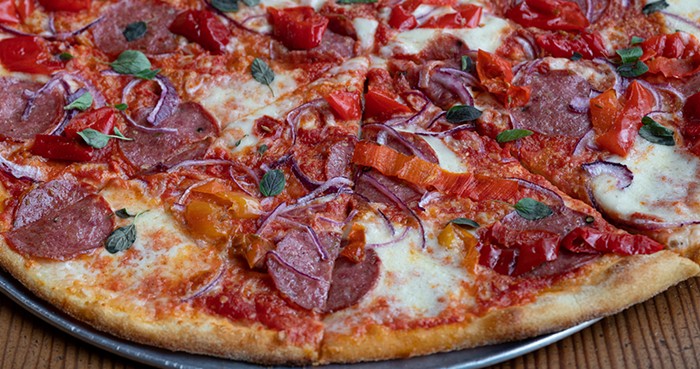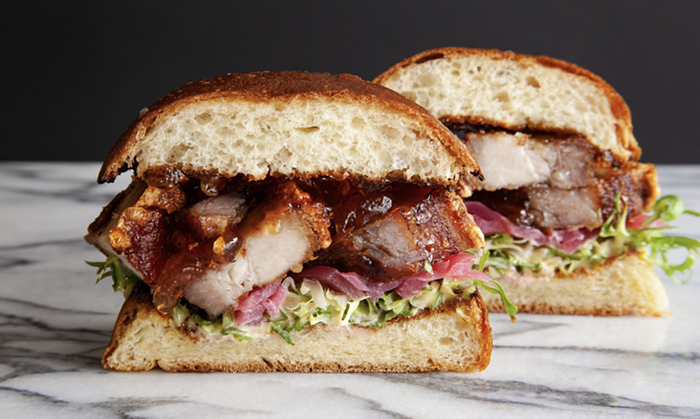Possibly you have not thought a lot about Pioneer Square since Elliott Bay Book Company decamped to Capitol Hill. But with the opening of Bar Sajor, we may anticipate the trumpeting of the neighborhood's renaissance. Bar Sajor has a forthcoming event space and bakery/floral partner called London Plane; it already has new neighbors Rain Shadow Meats Squared and Il Corvo, and there are more restaurants and retail to come. It will all be hailed as our reclaiming, at last, of Pioneer Square's cobblestone streets and stately brick buildings from the sailors and the tourists and the sports fans, and, importantly, from the chronic inebriates of both the homeless and the club-going varieties. But maybe you have gone to the neighborhood's many art galleries on First Thursday, or eaten a sandwich at Salumi or the Berliner, or tasted sake at Sake Nomi, or played pool at Temple Billiards, or ventured into the Double Header (all recommended). All was not lost, but fresh greatness is always welcome.
It is true that, viewed through Bar Sajor's soaring windows, Pioneer Square looks newly gorgeous in its old-fashioned glory. Sajor (pronounced "sigh-YOUR") is on the corner of Occidental Park at Jackson. Inside, the space seems sky-high, and everything is shipshape: the banquette seats with their blue-and-white mattress-ticking coverings, the white-painted brick and silver-topped bar, the tidy ceiling echoing the white wainscoting. It's got a French-country lightness and a sense of humor, too: mirrors decked out with gilt elephants and birds, a Nirvana album stuck behind the bottle of Chartreuse, an old vault keeping its secrets with the door closed. Outside, as night falls, you see the leaves on Occidental Park's trees, the faded writing on the old Shoe Building, an orange construction crane poking up behind the red brick. You catch a glimmer in the glass that is the reflection of the leaping fire in the open kitchen. Bebop plays. From here, Pioneer Square looks like the prettiest part, maybe the citiest part, of our city.
Bar Sajor's chef/owner is Matt Dillon, of Sitka & Spruce, Bar Ferd'nand, and the Corson Building (and Food & Wine's 10 best new chefs in 2007, and James Beard Best Chef Northwest 2012). Sajor is Dillon's mother's maiden name, and while "Sajor" is Polish, the bar of the same name serves food influenced by a stripe of Mediterranean, including North Africa, Spain, and Portugal, made with ingredients that are seasonal and local, or at least mostly so. If Dillon gets a line on jars of caper blossoms from Sicily, he will not hesitate to use them. The open fire in the open kitchen has an impressive rotisserie loaded with a flock of chickens—sourced from a family farm, because Mad Hatcher in Ephrata is not up to Dillon's standards. Bar Sajor also has a wood-fired oven and wood-fired grill—no stove, no range. Dillon's right-hand man here is Edouardo Jordan (from Sitka & Spruce and, before that, Per Se, the French Laundry, and the Herbfarm). And—no surprise, really, here—they are making excellent food, among the best in our city.
Bar Sajor's food is not merely delicious, it is also healthy, for Matt Dillon (appearances to the contrary) is a damn hippie. Evidence: He is cooking everything by fire, all natural-like. He worries, arguably excessively, about the happiness of chickens. He lives on a farm (the Old Chaser Farm) on an island (Vashon). He is making his own vinegar (with which he makes hale drinks) and bread (three kinds, including a sourdough that is as stellar as bread can be) and pickles (which he says make people burpy, but then they feel so good the next day). Bar Sajor's menu has lots of things that are sprouted, and seeds, and even kombucha on draft. The establishment is stylish and upscale, and Dillon himself is close-cropped and jovial, but the case rests itself.
Your visit to Bar Sajor starts with complimentary tea in a pretty little Moroccan-looking glass, Ceylon tea made with nettles, spearmint, raspberry leaf, fennel, and rose, sweetened with honey, which manages to taste both ethereal and salubrious at the same time. A dish of the pickles ($7.50) might include parsnips, brussels sprouts, chanterelles, beet, okra, turnip, some of which will be so vinegary that you will wince even as you reach for more. The housemade yogurt ($10), strained for three or four days, sounds like a second-tier choice on a menu laden with more glamorous options, but with its crisp sheets of caraway cracker, those salty-sweet caper blossoms, fresh dill, mint, and a shimmer of olive oil, it is so rich and smooth and just delicious, you can't quite believe it. It would go beautifully with the resident Chinook salmon ($15), which is silky in texture and faintly orchard-like in taste, having been cured in-house with calvados and apple mash, but the pairing might seem rote—or rote compared to dressing the salmon minimally with radishes and sprouted lentils, a peppery and earthy contrast to the fish.
Speaking of salmon, the next time someone asks where to get seafood in Seattle, Bar Sajor should probably be the answer. I ate a salad of bycatch octopus that had been braised in the wood-fired oven with vinegar, chilies, and walnut shells ($14.50). It had a restrained oceangoing flavor, a bouncy but tender texture—sometimes a little chewy but never rubbery—and came with a thick walnut sauce, dill for freshness, and an oozing egg yolk for vivid creaminess and color. Half of a chilled Dungeness crab ($18) was as sweet as crab gets unless you've pulled it up yourself, and what was described as garlic mayonnaise was a fluffy cream so good, we saved it and tried it with everything else we ordered. Halibut ($28) was cooked in buttermilk, brightened with leaves of sorrel, and dressed with sour butter (an accident that Dillon decided to use instead of throw away): It was pure and simple and great. Only the smelt ($14) were less flaky than ideal, but the accompanying nettle, shallot, and mint were almost fresh and crunchy and tart enough to make up for it—almost.
Of course there's meat, too, including a musky, intense housemade chicken-liver pâté ($12.50) sparked with pickled huckleberries and shallot. And the rotisserie chicken costs $21 for a half-bird and $39 for a whole, and is entirely worth it—be sure to push it through the thin but full-flavored tarragon broth on the plate. The chuletón de buey is a Spanish-style grilled rib steak for two that comes with a bottle of Basque hard cider for $50; I have not tried this yet only because of limited time and stomach-space. But do not overlook a salad of raw winter greens ($9/$14) and the list of vegetable sides ($9.50)—though some of the cidery-sweet hedgehog mushrooms were gritty one night, the blackened parsnips were just plain fantastic. And the desserts here, if you make it that far, are simple and smart and not too sweet: a plate of cookies plus little huckleberry jellies that each have the flavor of an entire pie, or an apple cake toasted up in the oven. You will also be given a silky-soft caramel, prosaically wrapped in brown paper.
Dillon envisions Bar Sajor as a bar in the Spanish or Portuguese sense, he says, "a casual place for simple food," one where you stop by after work and have a conversation and a drink and a snack, which the wine list facilitates with the likes of affordable rosés. Only a little of the space is given over to a handful of restaurant-ish seating, with the rest for bar-sitting or perching at high tables or standing around. Be warned: Reservations are not taken, and once people get here, they will be reluctant to leave this sweet spot in the old, still-beating heart of our city. ![]()



















